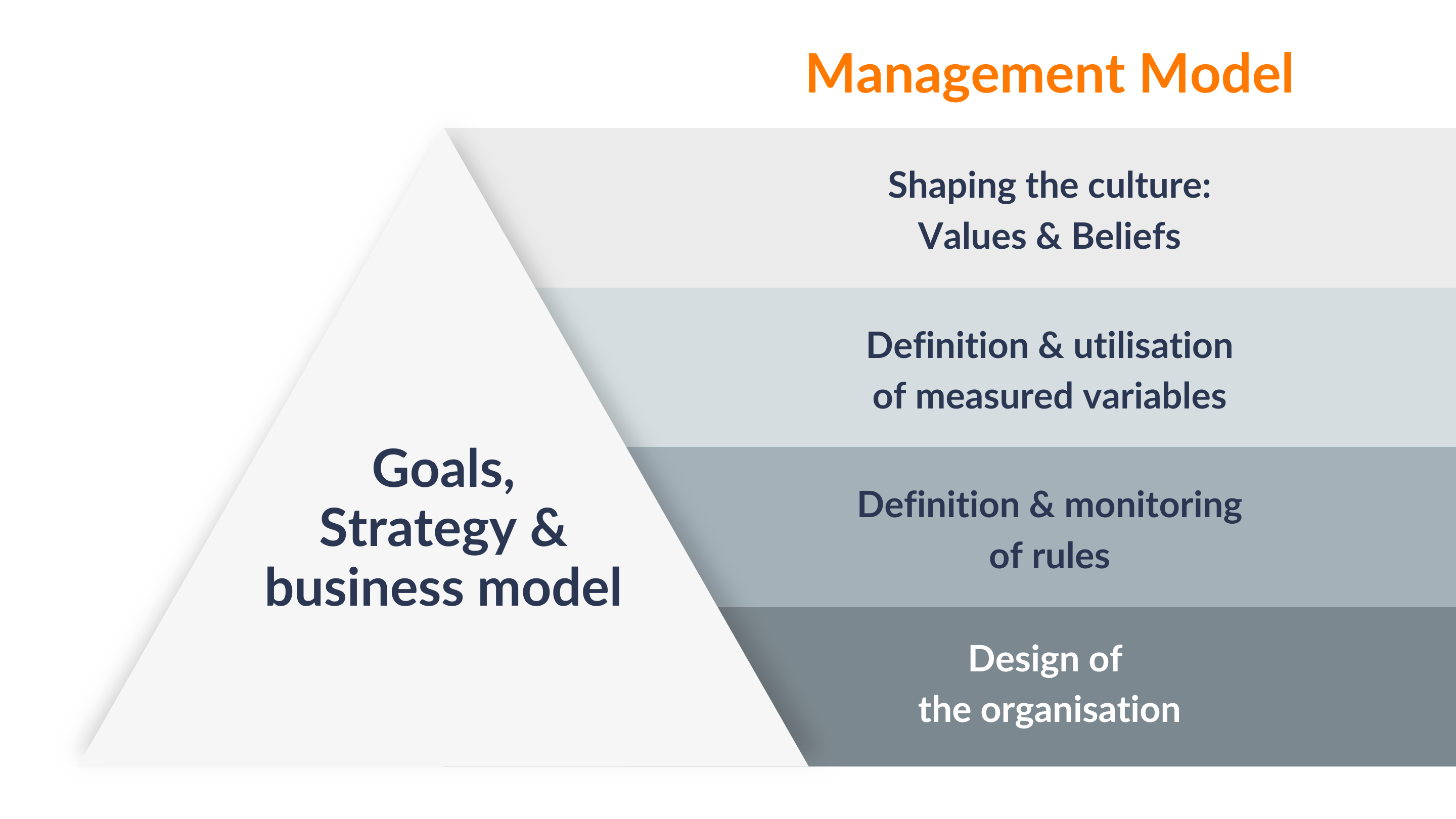Start Your Expedition
Rethinking Management: How Companies Remain Future-Proof Through Adaptive Management
Experience shows that companies often take shortcuts when designing their management models, focusing on metrics and organizational structures. Corporate culture is frequently seen as a given and not subject to influence, and the impact of rules and incentives on culture is often overlooked. In designing the organization, core processes, business models, or strategies are not sufficiently considered. Furthermore, companies must adapt to rapidly changing and increasingly data-intensive business models, necessitating a better understanding of management systems and their effects. These systems must be adaptively designed to support companies during significant transformations.
Four Levers of the Control Model, to be Designed in Relation to Each Other
In his framework on the interplay between control and management systems, Robert Simons differentiates four levers of control in a management model, which need to be closely aligned with each other considering their interrelationships for business success:
- Corporate Culture
- Business Area Focus
- Corporate Organization
- The use of Key Performance Indicators (KPIs) as a quantitative measure. But how do these levers steer a company, and how are they interconnected?
Within the corporate culture, the vision, and thus the question of what a company aims to achieve, plays a central role. By communicating goals transparently, motivation and connection among employees can be enhanced, and potential new customers and investors can be convinced. This is accompanied by focusing the business area on a clearly defined field of activity, including the demarcation of what the company does not do. This ensures that available resources are used as efficiently as possible. Building on this, the organization of a company should be designed in such a way that the assigned roles and responsibilities best support the business model and allow a frictionless, efficient flow of core processes. Whether the organization is primarily oriented towards the market and customer side, the product, or functions depends on the needs for individuality and speed on one hand, and scalability and size advantages on the other. From fundamental business concepts and business model-specific KPIs, a performance measurement model can finally be developed, with the help of which the performance of a company can be objectively quantified and controlled.
Central Success Factors for Implementation
- Understanding and Commitment at All Levels: The introduction of a holistic control model requires a profound understanding and commitment from all stakeholders. It starts with the executive management setting the vision and communicating the importance of the model.
- Integrated View of Control Elements: The four levers must be viewed and designed as an integrated system to create synergies and effectively control the entire company.
- Flexibility and Adaptability: The model must be flexible enough to respond to changes in the business environment. This requires regular evaluations and adjustments.
- Data-Driven Decision Making: The use of KPIs and other performance measurements is crucial for making objective decisions and continuously improving company performance.
Without a clear vision of the future finance organization, the CFO area will become the dinosaur of the company!
Insights
4C Whitepaper: Cost Management - more than just Cost Reduction
Our 4C Whitepaper shows the advantages of potential management. Optimize your cost structure now!
4C Whitepaper: Top Management Reporting
Effective corporate management with clear KPIs. Discover the 4C approach for optimal management cockpits. Read now!
4C Whitepaper: Key Figure Management
Use key figures specifically for strategic and operational goals. Find out more about selection, data collection, analysis and deriving actions. Read now!
Our Approach
Navigating the Future Securely: Holistic Management Models as the Key to Success
At 4C GROUP, we are convinced that to securely guide companies through the unknown waters of the transformation process in the future, the management model must be thought of holistically and designed adaptively. Only when corporate culture, business sector, organization, and metrics model are harmoniously aligned, and the management model can be flexibly adapted to changing environmental influences, can company-specific goals be achieved.
Workshop Series with Executives
We are developing the vision through a series of focused workshops to foster a shared understanding and commitment.
Integrative Analysis of the Four Levers
A comprehensive analysis ensures that all elements of the management model are harmoniously aligned.
Adaptive Implementation Framework
Our approach allows for flexible adaptation of the model to new challenges and opportunities.
Do you have any questions or would you like to find out more about our services?
Contact us for a non-binding consultation.
Why 4C?
- Experience and Expertise: As a specialized management consultancy, we possess extensive experience and a deep understanding of adaptive management models. We offer tailor-made solutions that are customized to meet the specific requirements of your business.
- Individual Solutions and Long-Term Support: We not only develop customized management models, but also provide long-term support through consulting and optimization to ensure that your company continuously grows and adapts.
- Measurable Success: Our work is based on proven results that enhance efficiency, adaptability, and business performance.
- Future-Proofing: With us as your partner, you secure the future viability of your business in a rapidly changing business environment. Contact us to take the first step together towards a future-proof management model.
Client Testimonials
"Working with the 4C GROUP as an external sparring partner, who not only talks about general topics on the surface, but also provides us with concrete approaches and methods for linking key figures, allows us to independently develop a transparent and meaningful management system. The mentoring is reflected positively and sustainably in our daily work".
More Topics
Your Experts
Contact Us
We would like to point out that this website provides only a limited insight into our services. Our expertise and full range of capabilities cannot be completely conveyed through this platform. For personalized consultation and to address your specific concerns in the best possible way, we warmly invite you to contact us directly so we can offer you tailored solutions.
Thank you for your trust. We look forward to hearing from you.











